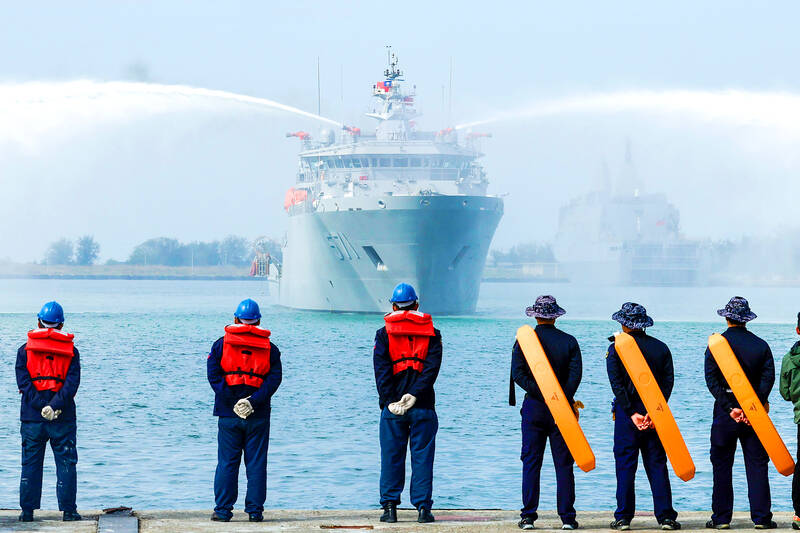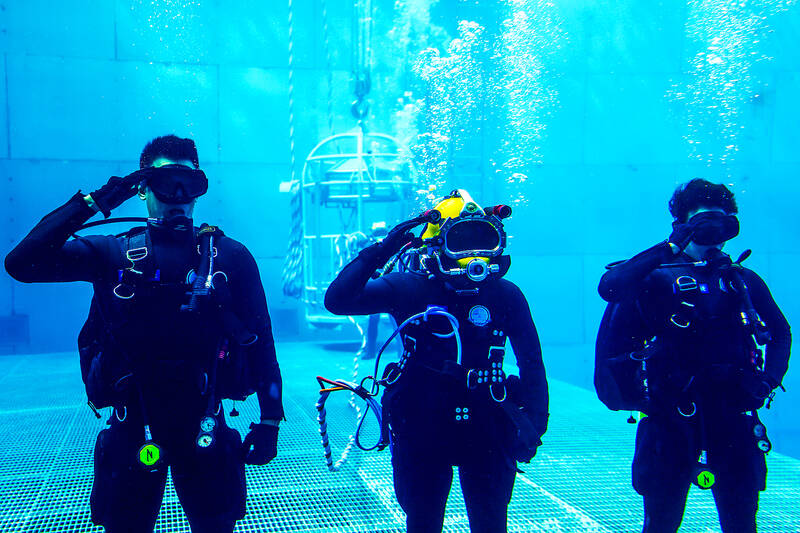Last week Elbridge Colby, US President Donald Trump’s nominee for under secretary of defense for policy, a key advisory position, said in his Senate confirmation hearing that Taiwan defense spending should be 10 percent of GDP “at least something in that ballpark, really focused on their defense.” He added: “So we need to properly incentivize them.”
Much commentary focused on the 10 percent figure, and rightly so. Colby is not wrong in one respect — Taiwan does need to spend more. But the steady escalation in the proportion of GDP from 3 percent to 5 percent to 10 percent that advocates call for was predictable and inevitable. Set the bar high enough, and eventually Taiwan cannot reach it. And the US can wash its hands of it. Is that the plan?
WHAT INCENTIVES?

Photo: EPA
Colby’s remark that Taiwan needs to be “incentivized” to spend at least realizes that Washington can play a role in getting Taiwan to spend more. He also remarked that losing Taiwan would be a disaster for the US. Finally, he stated that he was “profoundly disturbed” by the pro-China parties — the Chinese Nationalist Party (KMT) and the Taiwan People’s Party (TPP) — slashing of defense budgets. Washington is aware of the problem. Hopefully the “incentives” Colby proposes will help address the problem of the China-aligned parties.
The stern moralizing of US-based commentators is in stark contrast to the reality of US military decline, a decline that has worsened palpably under Trump. Atlantic Council Fellow Elizabeth Braw explained this in Foreign Policy last week in a piece entitled “How Trump Is Killing the US Defense Industry.”
Braw observes that foreign leaders, seeing the way Trump treated Ukrainian President Volodymyr Zelenskiy, will conclude “that US security guarantees — a key reason why countries tend to buy US weapons—are not going to be a convincing argument anymore.”

Photo: EPA-EFE
The stock prices of US defense firms have slid 4 percent in the six weeks that Trump has been in power. Since European leaders now believe the US is no longer a reliable partner, their weapons purchases will shift to locally produced systems, Braw said. The stock prices of European defense firms have all risen as markets realize this.
Trump’s shocking, self-destructive reversal of longstanding American foreign policy has obscured the burgeoning impact of Elon Musk’s Department of Government Efficiency (DOGE) on US defense readiness. Last week Senator James Lankford of Oklahoma warned that DOGE wanted to slash jobs at the McAlester Army Ammunition plant in his home state.
“We can’t do ordinance if we remove 1000 civilians there,” Lankford said.
McAlester is a critical ammunition supplier. DOGE was also ripping away jobs at Tinker Air Force Base in Oklahoma, a key facility in US military aircraft maintenance. Colby has his work cut out for him, if his goal is to increase investment in the defense industrial base.
The ongoing demolition of the US alliance system and industrial base, combined with the negative effects of DOGE on government efficiency, bodes ill for the defense of Taiwan. It also makes it far more difficult to “incentivize” Taiwan to double or triple defense spending, since without US military intervention, Taiwan is doomed no matter how much it spends. Nor can defense spending by Taiwan (or the Philippines or Japan) deter the People’s Republic of China (PRC), despite widespread magical thinking among commentators in this regard. Only the threat of US intervention can do that.
NUMBERS DON’T ADD UP
But, assuming that the US will intervene if defense spending actually reaches that elusive, ever-receding goal that will please US policymakers, what goal is reasonable? Taiwan’s GDP last year reached US$793 billion, making 10 percent around $79 billion. The fiscal year budget last year was NT$2.85 trillion, or US$86 billion. That’s right, to reach 10 percent of GDP, Taiwan would have to convert its entire government budget to military spending, a fourfold increase in defense spending at fiscal year 2025 levels of US$19.7 billion (2.45 percent of GDP). Such a figure is absurd.
Even reaching 5 percent of GDP would require more than doubling the current defense budget. Are Taiwan’s relatively untaxed wealthy willing to pay more taxes for that?
Increases also imply other issues. In a recent piece at Global Taiwan Institute, Jeremy Chen (張智程) pointed out the growing problem of diminishing returns to military spending: growing costs for personnel, materials and maintenance costs squeeze procurement budgets. Doubling funding will thus not double performance. And still, US commentators will complain that it is not enough.
A better move for US-based pundits would be to stop demanding specific percentages or sums, all of which are unrealistic given Taiwan’s low tax take and the current legislature, controlled by the pro-PRC parties. Instead, the US can incentivize Taiwan to invest more in its defense over time by taking concrete actions that signal to all parties it remains strongly committed to the nation’s defense.
MEANINGFUL PROPOSALS
Many of these were in fact laid out in a bipartisan proposal containing 10 recommendations to deter the PRC by the House China Committee. Among other things, it called for pre-positioning munitions in Taiwan, joint training, a joint planning group, a joint headquarters group, hardening US Pacific bases, ramping up munitions production in the US and pre-planning for sanctions in coordination with US allies in Asia. These must be carried out.
What the US should also be doing is increasing its visible footprint in Taiwan. That will help it counter the steady flow of US skepticism served up by PRC propaganda. Having Major General Jay Bargeron of the US Indo-Pacific Command observe the recent Han Kuang military exercises last week was a good start (his identity should not have been downplayed). High ranking military officers should be regular and heavily publicized visitors. Familiarization trips by small groups of US military personnel who could be encountered across the island by the ordinary public would be even better.
In 2017, the US Senate Committee on Armed Services passed a provision that would permit US naval vessels to visit Kaohsiung or “other suitable ports.” The following year a US naval research vessel visited. It visited again last month, but both visits were low-key. Such visits need to become normalized and include a much greater range of vessels until warships can dock without much protest from the PRC. After all, Beijing will be bellicose whether or not the US does port visits.
Finally, the US should also begin a program of munitions procurement from Taiwan, which would enable it to expand its military production without increasing its military budget. US lawmakers and government officials also need to continue loudly scolding the China-aligned parties for their cuts to the proposed budgets. The US can also signal Taiwan by making its military relations with Japan more visible to Taiwan, and by rapidly expanding its military industrial base.
Simply demanding that Taiwan spend more, without major changes in US policy involving concrete cost signals of US commitment, will help the pro-China side argue that the US is useless, unreliable and venal. Indeed, this position has been made eminently reasonable by the US abandonment of Ukraine. Like it or not, US policymakers will have to shape their Taiwan policies to account for the effects of that historic betrayal.
Notes from Central Taiwan is a column written by long-term resident Michael Turton, who provides incisive commentary informed by three decades of living in and writing about his adoptive country. The views expressed here are his own.

A vaccine to fight dementia? It turns out there may already be one — shots that prevent painful shingles also appear to protect aging brains. A new study found shingles vaccination cut older adults’ risk of developing dementia over the next seven years by 20 percent. The research, published Wednesday in the journal Nature, is part of growing understanding about how many factors influence brain health as we age — and what we can do about it. “It’s a very robust finding,” said lead researcher Pascal Geldsetzer of Stanford University. And “women seem to benefit more,” important as they’re at higher risk of

Eric Finkelstein is a world record junkie. The American’s Guinness World Records include the largest flag mosaic made from table tennis balls, the longest table tennis serve and eating at the most Michelin-starred restaurants in 24 hours in New York. Many would probably share the opinion of Finkelstein’s sister when talking about his records: “You’re a lunatic.” But that’s not stopping him from his next big feat, and this time he is teaming up with his wife, Taiwanese native Jackie Cheng (鄭佳祺): visit and purchase a

April 7 to April 13 After spending over two years with the Republic of China (ROC) Army, A-Mei (阿美) boarded a ship in April 1947 bound for Taiwan. But instead of walking on board with his comrades, his roughly 5-tonne body was lifted using a cargo net. He wasn’t the only elephant; A-Lan (阿蘭) and A-Pei (阿沛) were also on board. The trio had been through hell since they’d been captured by the Japanese Army in Myanmar to transport supplies during World War II. The pachyderms were seized by the ROC New 1st Army’s 30th Division in January 1945, serving

The People’s Republic of China (PRC) last week offered us a glimpse of the violence it plans against Taiwan, with two days of blockade drills conducted around the nation and live-fire exercises not far away in the East China Sea. The PRC said it had practiced hitting “simulated targets of key ports and energy facilities.” Taiwan confirmed on Thursday that PRC Coast Guard ships were directed by the its Eastern Theater Command, meaning that they are assumed to be military assets in a confrontation. Because of this, the number of assets available to the PRC navy is far, far bigger